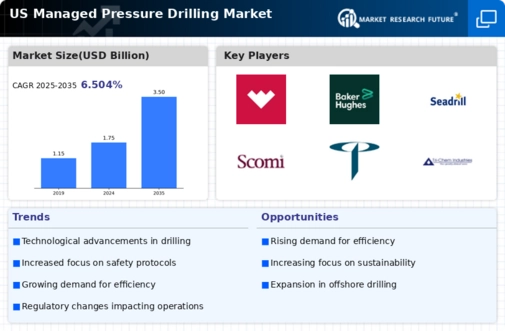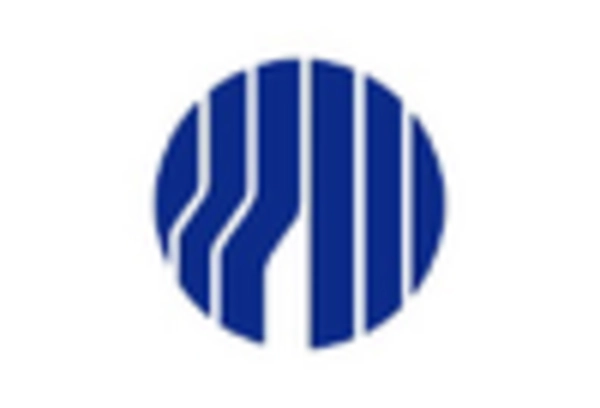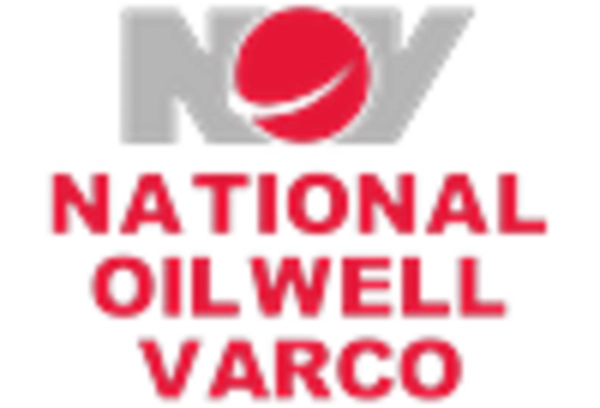Rising Environmental Concerns
Environmental concerns are increasingly influencing the managed pressure-drilling market, as stakeholders seek to minimize the ecological impact of drilling operations. The US has seen a growing emphasis on sustainable practices, with regulations aimed at reducing emissions and protecting natural resources. Managed pressure drilling offers a solution by enabling more precise control over drilling parameters, which can lead to less waste and lower environmental footprints. As companies strive to comply with stricter environmental regulations, the managed pressure-drilling market is expected to expand. This shift towards environmentally responsible drilling practices may also attract investment, as firms look to align with sustainability goals and enhance their public image.
Increasing Demand for Energy Efficiency
The managed pressure-drilling market is experiencing a notable surge in demand driven by the need for enhanced energy efficiency in drilling operations. As energy costs continue to rise, operators are increasingly seeking methods to optimize their drilling processes. Managed pressure drilling allows for better control of downhole pressure, which can lead to reduced non-productive time and improved overall efficiency. According to recent estimates, the adoption of managed pressure drilling techniques can enhance drilling efficiency by up to 30%, thereby significantly lowering operational costs. This trend is particularly pronounced in the US, where energy companies are under pressure to maximize output while minimizing expenses. Consequently, the increasing focus on energy efficiency is likely to propel the managed pressure-drilling market forward, as companies invest in advanced technologies to meet these demands.
Growing Investment in Oil and Gas Exploration
The managed pressure-drilling market is benefiting from a resurgence in investment in oil and gas exploration activities. As energy demand continues to rise, particularly in the US, companies are increasingly allocating resources towards exploring new reserves. Managed pressure drilling techniques are particularly advantageous in challenging environments, allowing for safer and more efficient extraction of hydrocarbons. Recent data indicates that exploration budgets in the US have increased by approximately 15% in the last year, reflecting a renewed confidence in the sector. This growing investment is likely to drive the managed pressure-drilling market, as operators seek to leverage advanced drilling technologies to maximize their exploration efforts.
Technological Innovations in Drilling Equipment
Technological innovations are playing a pivotal role in shaping the managed pressure-drilling market. The introduction of advanced drilling equipment and software solutions has revolutionized the way drilling operations are conducted. Innovations such as real-time monitoring systems and automated control mechanisms enable operators to make informed decisions quickly, thereby enhancing safety and efficiency. The US market has seen a rise in the deployment of these technologies, with investments in smart drilling systems increasing by approximately 25% over the past few years. This trend suggests that as technology continues to evolve, the managed pressure-drilling market will likely benefit from improved operational capabilities and reduced risks associated with drilling activities.
Enhanced Safety Protocols in Drilling Operations
Safety remains a paramount concern in the managed pressure-drilling market, with operators continuously seeking to improve safety protocols. The implementation of managed pressure drilling techniques has been shown to reduce the risks associated with well control incidents, which can have catastrophic consequences. In the US, regulatory bodies are increasingly mandating stricter safety standards, prompting companies to adopt advanced drilling practices. The integration of real-time data analytics and automated systems in managed pressure drilling enhances situational awareness, thereby improving safety outcomes. As the industry prioritizes safety, the managed pressure-drilling market is likely to see increased adoption of these techniques, ultimately leading to safer drilling operations.

















Leave a Comment